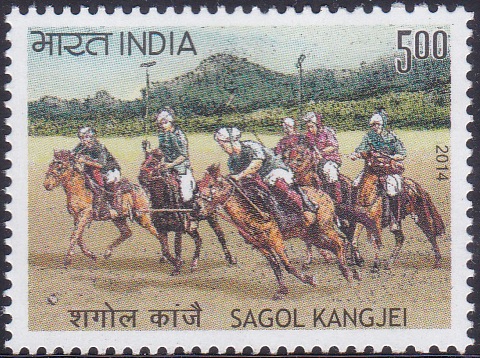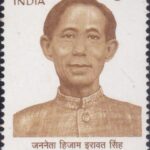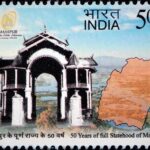
Sagol Kangjei
A commemorative postage stamp on the 150th Anniversary of Sagol Kangjei (Polo) :
Issued on Nov 29, 2014
Issued for : Department of Posts is happy to release a Postage Stamp to commemorate the occasion of the 150th anniversary of introduction of Sagol Kangjei to the world.
Credits :
Stamp/FDC : Kamleshwar Singh
Cancellation Cachet : Nenu Gupta
Type : Stamp, Mint Condition
Colour : Multi colour
Denomination : 500 Paise
Stamps Printed : 0.6 Million (0.1 Million for the proponent)
Printing Process : Wet Offset
Printer : Security Printing Press, Hyderabad
About :
- “Sagol Kangjei“ is derived from the two Manipuri words ‘Sagol’ for horse and ‘Kangjei’ for hooking stick. Lt. Joseph Ford Sherer, who was instrumental in introducing the sport to Europeans, in 1859, as a young lieutenant and adjutant of the 44th (Sylhet) Regiment of (Bengal) Native (Light Infantry), along with Captain Robert Stewart, Superintendent of Cachar, founded a European Polo Club. Five years later, in the year 1864, Sherer and his team of seven Manipuri men, nicknamed ‘The Brothers‘, took the game to Calcutta where it immediately became very popular. George Frederick Samuel Robinson, 1st Marquess of Ripon, former Viceroy of India, while speaking in the British Parliament (House of Lords) on 22nd June 1891, described Manipur as the birth place of Polo.
- The story behind the origin of the game in Manipur is very interesting. King Kangha, who reigned Manipur in 3300 B.C., is believed to have introduced Sagol Kangjei. During a festival known as Ukrong Hongba, he demonstrated how a bamboo root clump could be dribbled with his walking stick, and asked his subjects to play the game on horseback. The game first found mention in the Royal Chronicle of Manipur, Cheitharol Kumbaba, in 33 AD.
- The game is played with seven members in each team, representing seven Manipuri ancestral clans. The players are mounted on Manipuri ponies which are four to five feet high but hardy and active. The ponies are fully decorated, with various guards protecting their eyes, forehead and flanks. The main implements used in the game are Kangjei, the polo stick, a long shaft of bamboo with a head of hard wood set on at an obtuse angle and the ball, Kangdrum which is made of bamboo root. The saddle used in the game is large, light and peaked both in front and the back. In addition to it, there is a pair of leather flaps which project around the legs of the rider and afford some protection from a blow.
- The rules of the game are not obvious. In fact, most observers of the sport declare that rules are conspicuous by their absence. A goal is scored in this game once the ball crosses the back line and the ball is again thrown in from the middle line, not along the ground, but in the air, so as to give occasion for a brilliant stroke of hitting it in mid-air or catching the ball by hand.
- Text : Based on the material furnished by the proponent.
Subscribe
Login
0 Comments
Oldest







